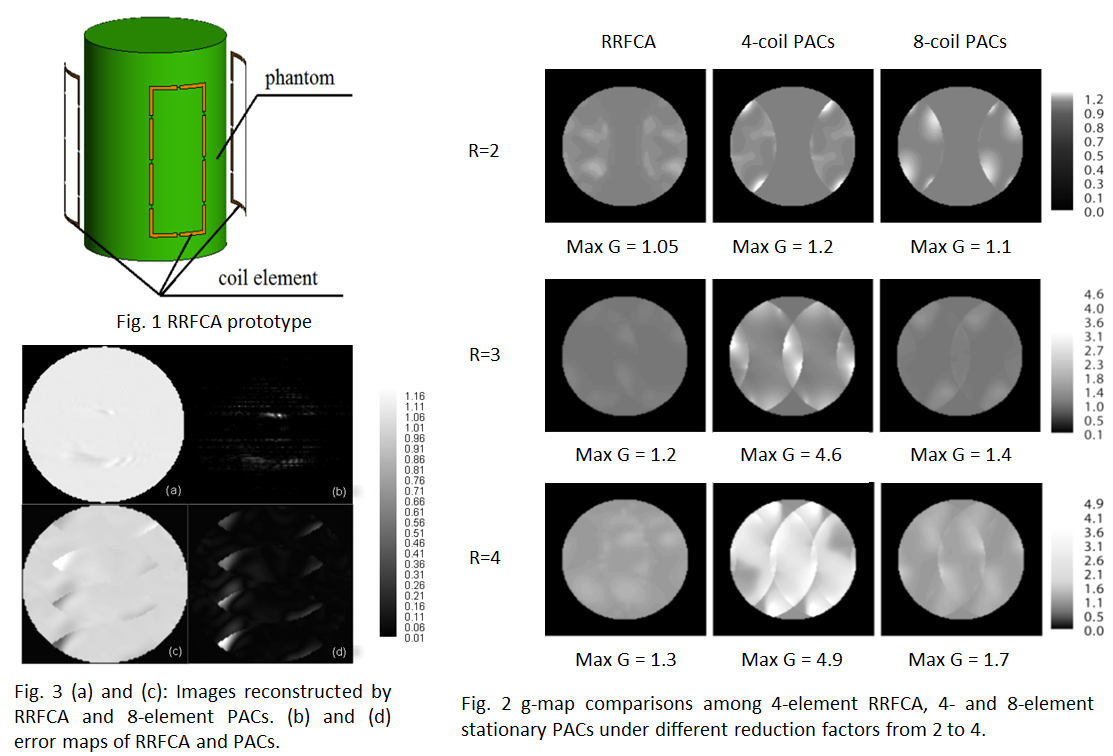posters 5th Asia-Pacific NMR Symposium 2013
High Imaging Acceleration with a Rotating Radiofrequency Coil Array at 7T (#170)
Introduction: To provide excellent parallel imaging performance without using a large number of coils in an array, we propose to strategically combine the rotating radiofrequency coil (RRFC) 1,2 with phased-array coils (PACs). In this approach, considerably more sensitivity profiles can be employed for sensitivity encoding (SENSE)3,4, thereby achieving higher reduction factor without increasing the number of coil elements.
Method: Fig.1 illustrates a prototype of rotating radiofrequency coil array (RRFCA) for MR neuroimaging that consists of 4 identical elements evenly distributed around the subject. After loading with a cylindrical homogeneous phantom (εr = 78, σ = 0.53), the mutual coupling between any two channels were under -23 dB without the employment of additional decoupling techniques. Electromagnetic modelling was performed with FEKO (EMSS, SA). The steady-state circularly-polarized RF magnetic field (B1) was calculated according to 5 with MATLAB (Mathworks, MA). Assume that the coil array steps through various azimuthal angles θ during sampling. By carefully choosing θ, sensitivity encoding ability of RRFCA can be optimised as 6,7:

where gx,y(θ) was the g-factor calculation at voxel (x, y) in a image with size N× N.

Results: Fig. 2 shows that, at all reduction factors, the RRFCA had the best imaging acceleration capability demonstrated by lowset max g-factor and most uniform g-map when compared to two conventional arrays. Fig. 3 (a) and (c) were the phantom images reconstructed by RRFCA and 8-element PACs, respectively. (b) and (d) correspond to the error maps of (a) and (c). The root-mean-standard-deviation and artefact power of RRFCA reconstructed images were improved 13.3% and 24% respectively, compared to stationary 8-element PACs.
Conclusion: This preliminary study showed obvious advantages of RRFCA in imaging acceleration and artefact suppression when compared to traditional stationary phased-array coils with same and doubled number of channels.
- A.Trakic, et al, Concepts in Magn Reson Part B: vol. 35B, 2009.
- A.Trakic, et al, J of Magn Reson,vol 201,2009.
- K. Pruessmann , et al, Magn Reson in Med, vol 42, 1999.
- K. Pruessmann , et al, Magn Reson in Med, vol 46, 2001.
- D. Hoult, Concepts in Magnetic Resonance, vol. 12, 2000.
- M. Li et al,ISMRM, SLC, 2013.
- M. Li, et al, IEEE EMBC San Diego, 2012.